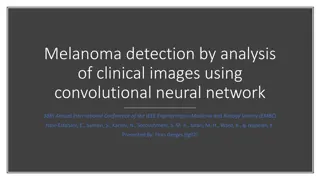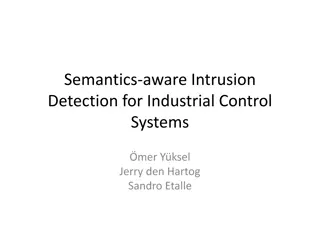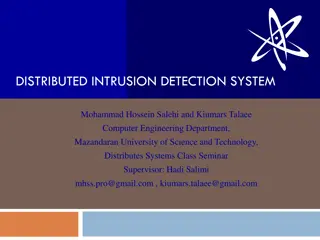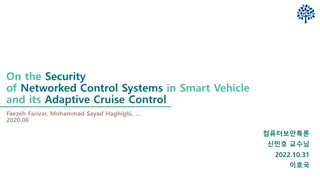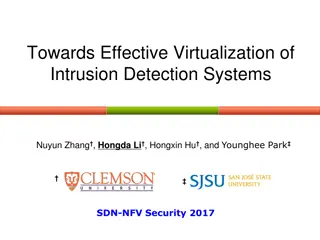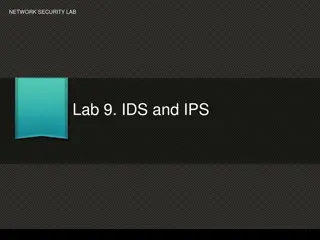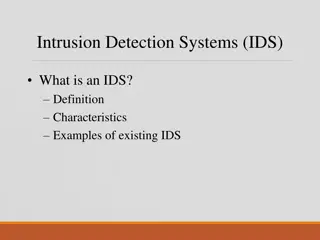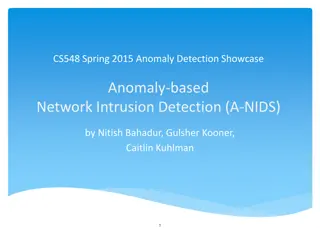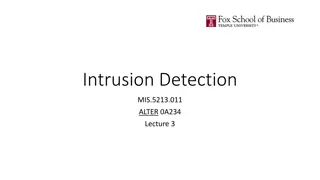
Intrusion Detection and Prevention Systems in Cybersecurity
Explore the importance of Intrusion Detection and Prevention Systems (IDS/IPS) in cybersecurity. Learn how these systems monitor network traffic, detect malicious activities, and leverage machine learning to enhance security. Understand the differences between IDS and IPS, their advantages, and disadvantages in safeguarding networks against cyber threats.
Download Presentation

Please find below an Image/Link to download the presentation.
The content on the website is provided AS IS for your information and personal use only. It may not be sold, licensed, or shared on other websites without obtaining consent from the author. If you encounter any issues during the download, it is possible that the publisher has removed the file from their server.
You are allowed to download the files provided on this website for personal or commercial use, subject to the condition that they are used lawfully. All files are the property of their respective owners.
The content on the website is provided AS IS for your information and personal use only. It may not be sold, licensed, or shared on other websites without obtaining consent from the author.
E N D
Presentation Transcript
Cybersecurity (Security+) and P4 Programmable Switches Intrusion Detection and Prevention Systems Ali AlSabeh, Jorge Crichigno University of South Carolina http://ce.sc.edu/cyberinfra Western Academy Support and Training Center (WASTC) University of South Carolina (USC) Energy Sciences Network (ESnet) June 21st, 2023 1
Intrusion Detection/Prevention System (IDS/IPS) Intrusion Detection System (IDS) and Intrusion Prevention System (IPS) monitor network traffic to detect and prevent malicious activities These systems are either implemented on a dedicated hardware or implemented as applications on a general-purpose server IDS and IPS are placed at strategic points in the network to be able to monitor traffic from all devices 3
Intrusion Detection/Prevention System (IDS/IPS) IDS and IPS leverage a database of attacks signatures to detect malicious traffic Signature-based IDS/IPS are popular and effective, but cannot detect zero-day attacks Machine learning can be leveraged to create a model of the normal behavior of the network Thus, the normal model can be used as a baseline to detect any abnormalities in the network 4
Intrusion Detection System (IDS) An IDS monitors the traffic of a network passively i.e., the IDS is not deployed inline in the topology Instead, a network device (e.g., switch, router) duplicates and forwards the traffic to the IDS The IDS then analyzes the traffic offline (promiscuous mode) and matches the traffic stream with known malicious signatures Advantages of IDS: It does not negatively impact the performance of the network It does not affect the network if a problem or misconfiguration of the IDS occurs Disadvantages of IDS: It cannot stop malicious single-packet attacks from reaching the target It requires assistance from other networking devices to respond to the attack 5
Intrusion Prevention System (IPS) An IPS device monitors the network traffic actively i.e., the IPS is deployed inline in the topology The IPS analyzes traffic online, thus, all ingress and egress traffic must flow through the IPS for processing Advantages of IPS: It can stop single packet attacks Disadvantages of IPS: It can negatively affect the performance of the network It can disrupt the network if a problem or misconfiguration of the IPS occurs 7
Identifying Malicious Traffic on the Network Signature-based IPS/IDS Set of rules looking for some specific pattern in a packet or stream of packets Most significant method used on today s IPS/IDS Policy-based IPS/IDS Traffic is matched based on the security policy implemented in the network Anomaly-based IPS/IDS A baseline of normal and malicious behavior is modeled and compared to the traffic flowing in the network Reputation-based IPS/IDS A collection of inputs from various sources is gathered, including the reputation of a certain IP address, domain, URL, etc. 9
IPS/IDS Evasion Techniques Traffic fragmentation Malicious traffic is split into multiple parts Traffic substitution and insertion Data payload characters are substituted into different formats Timing attacks Malicious traffic is sent at slow time intervals Encryption and tunneling Malicious traffic is encrypted and cannot be easily inspected Resource exhaustion Thousands of alerts are generated 10
Suricata 11
Introduction to Suricata Suricata is an open-source engine Intrusion Detection System (IDS), Intrusion Prevention System (IPS) It is capable of performing Deep Packet Inspection (DPI) Suricata has the following properties: Multithreading: multiple cores can be allocated to a single Suricata instance Application ID: Suricata can detect the application type, regardless of the port number Supports logging of events Extensible through a scripting language (Lua) Suricata is backed by the Open Information Security Foundation (OISF) 12
Multi-threading Engine Networks today process traffic in the order of tens and hundreds of Gigabytes per second Multithreading allows scaling horizontally on a single appliance 13




